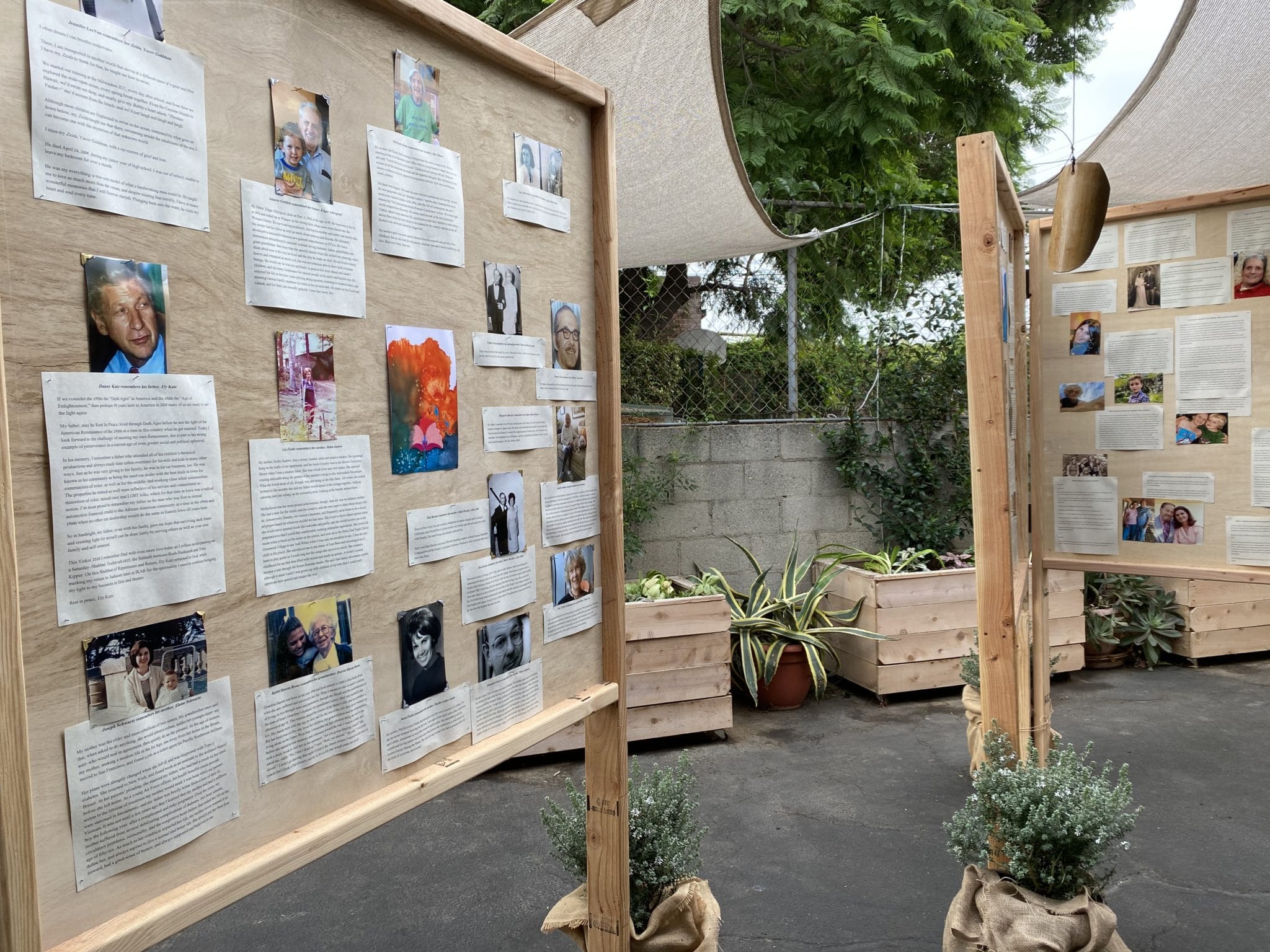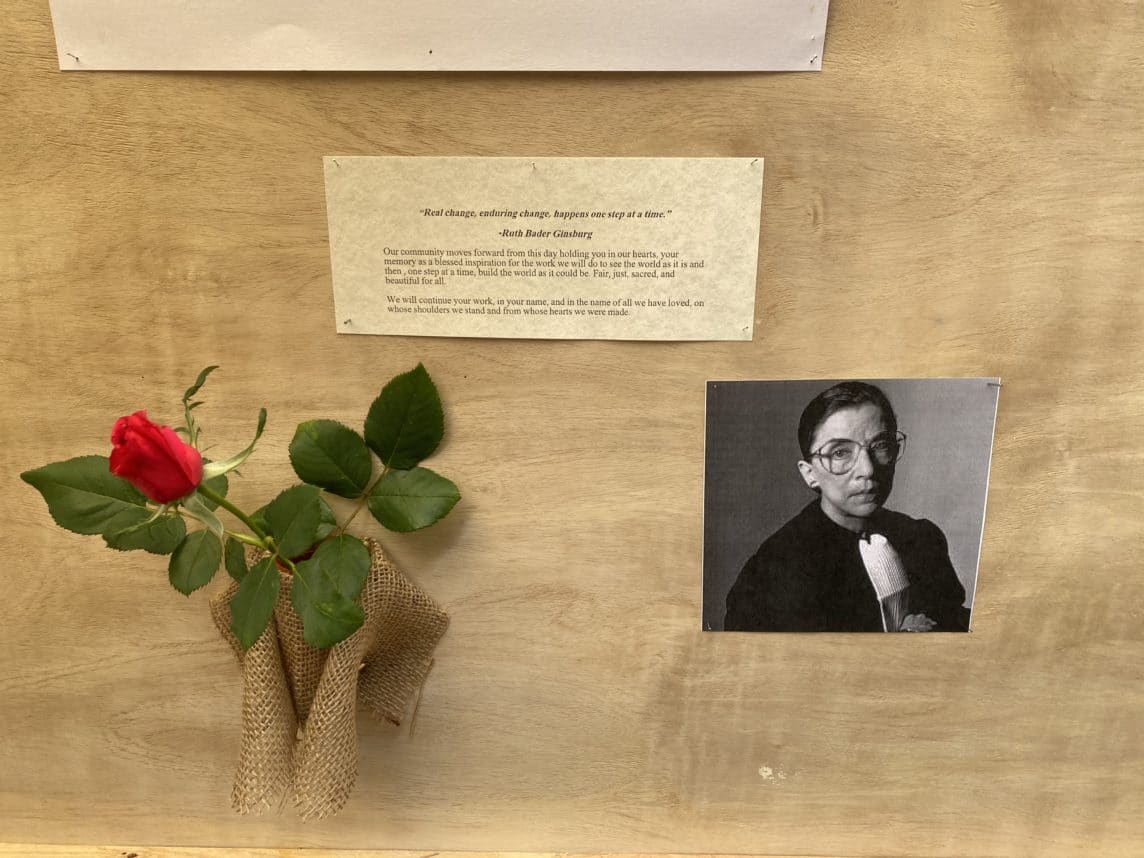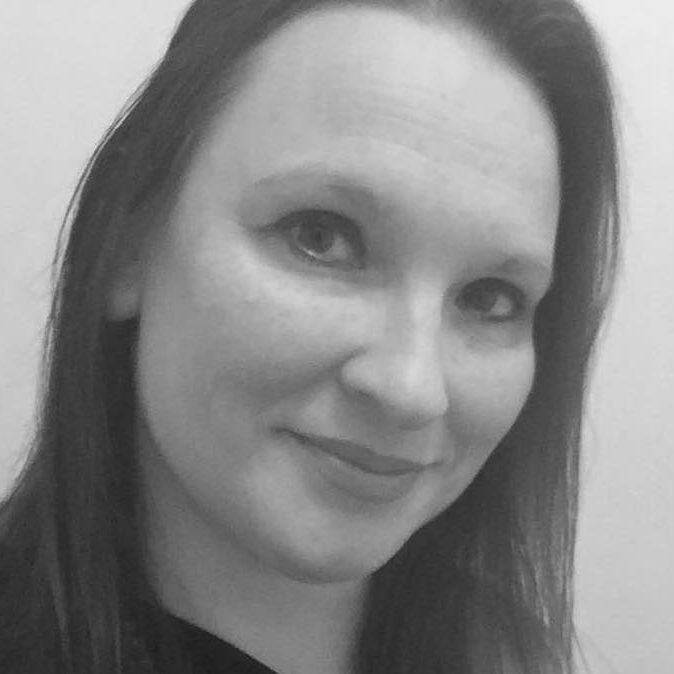 Photos courtesy of Samara Hutman
Photos courtesy of Samara Hutman IKAR publishes a Yizkor book every year that features members’ stories of loved ones who have died. Reading these reflections during Yom Kippur services — along with the Yizkor service — was a way to connect deeply with other IKARites, and to serve as witnesses to their loss and learn more about how they became the people they are today.
This year, as with everything relating to the High Holy Days in the era of COVID-19, the space that IKAR carves out for grief had to be rethought. The result is IKAR’s Yizkor Memorial Garden, a physical space on IKAR’s patio off La Cienega Boulevard, with an exhibit that holds people’s memories and limits the number of visitors at any one time for health and safety reasons.
IKAR Assistant Rabbi Keilah Lebell, who created the space with co-chairs and IKAR members Samara Hutman and Sarah Goldfinger, said the goal was to create “a way for people to come to a physical space and have a Yizkor moment that didn’t have anything to do with a screen.”

Feedback from several mourners shaped a more interactive experience that also adhered to safety guidelines. Hutman, who had been a set decorator for years, suggested a garden, Lebell said, and created “something that’s alive, where people could visit and spend time there.” Lebell credited Goldfinger for knowing “how to create sacred space and a sense of beauty.”
“[The experience] had to be something touch-free,” Goldfinger said. “How do you create a space that feels interactive even if you’re not touching anything?”
“We were groping for how people can be together because it’s been so painful to mourn in isolation.” — Samara Hutman
The team settled on asking visitors to take a stone with them from the entrance and deposit it in a mandala’s spiral before they exit. “When you go to a cemetery, you leave a pebble,” Goldfinger said. “With our stone activity, the idea is to pick one up and carry it through and put it in a spiral in a sacred community of mourners. So even though you didn’t touch anyone, you see people mourning with you.” She added, “The sculptures and mandalas on the ground do the job of ushering you into the space.”
Hutman said, “We were groping for how people can be together because it’s been so painful to mourn in isolation.”
Lebell noted that one guiding idea was the wall of candles present in many churches. “You might be completely alone but you light a candle and see the other candles that are lit and know that others have been there,” she said. “We are all part of this space together, creating connection between community members.”

On Monday afternoon, the garden was empty of people, but the breeze carried sounds that you only hear when human voices are absent: air lightly whipping at sheltering tarps, wind chimes tinkling idiosyncratically, the bubbling fountains creating a spa-like calm.
“It is a very holy place,” Hutman said. “I myself have been healed here over the course of weeks as we took it from idea to place, to human space with dimension, and quotidian rhythms: pruning the plants and sweeping the paths; listening to the chimes in the wind; watching fiery skies with worry; welcoming the blue sky and the sun back, and [welcoming] purer air back in the last few days.”
At the center of the space, the team installed bulletin boards with 200 photos and 250 written reflections of members’ lost loved ones. “We wanted the boards to be the centerpiece of activity,” Goldfinger said.
The boards tell stories of parents long gone or recently departed; friends taken too soon; beloved grandparents who shared wisdom or took their secrets with them; and the children whose heartbreaking smiles remind you anew of what was lost. Together, the words and images begin to fill out the contours of community. Because of these people, we are the people we are today.
There’s also an acknowledgment of more global losses, from the Holocaust to the COVID-19 pandemic, and the destruction caused by California’s most recent fires. By the Monday morning after her passing, the volunteers had added a section dedicated to Supreme Court Justice Ruth Bader Ginsburg.
I took comfort in the silence, and in knowing no one was pressing me to move forward. When others arrived, we talked at a distance, but not in the hushed, reverent tones of a memorial. We are desperate for mask-to-mask conversation, for the third dimension of our community to be restored, so we can stand with one another during challenging moments.
Goldfinger said she thought a lot about past experiences of “being in a room saying Kaddish with other people and feeling that we’re all in this together, having someone to nuzzle up against. It’s really moving to be able to grieve that way,” as people did before the pandemic, she said. “I didn’t set out at the beginning to replace that feeling, but [the garden is] like a hug.”
Pamela Jacobson, one of the volunteers who worked to create the space, called it “incredibly therapeutic after being so isolated for several months. It was an unexpectedly powerful and positive experience,” she said. “Reading the stories, seeing the images and working with my hands in collaboration with others to create something so beautiful and meaningful was a gift that brought me a new sense of hope and possibility.”
Added Hutman, “It is in the symphony of collected stories and faces, in the aching tug of loss and the durability of the connection that remains, that we fully understand the precious fragility of life and the durable power of love.”

In keeping with COVID-19 safety guidelines, there are sanitizing stations at the entrance and exits, and visitors must wear masks and maintain 10 feet of distance. Only eight people are permitted in the garden at any one time.
“An important facet of the garden is the way it has reconstituted, in space and place, the soul of our community, through the physicalization of our Jewish commitment to collective memory, grief and prayer,” Hutman said. “At a time when we are required to be apart, this opportunity to gather is a gift for all of us who used our hearts and hands to create it, and for all who will enter and experience it.”
Seeing my mom in the middle of that collage in a bright yellow shirt, smiling, looking slightly off-camera with delight upon some grandchild who is just out of frame, I like to imagine that she can see me and the other people who are visiting this space, as if it were a two-way mirror. As people pass in front of her photo, I know they are getting a window into her life and impact. Perhaps she’s also getting a window into mine.
For security reasons, contact Membership@ikar-la.org for hours and information. Those who have been in contact with anyone infected with COVID-19 in the previous 14 days, including anyone who is experiencing or displaying symptoms of COVID-19, are asked not to enter the garden.






















 More news and opinions than at a Shabbat dinner, right in your inbox.
More news and opinions than at a Shabbat dinner, right in your inbox.